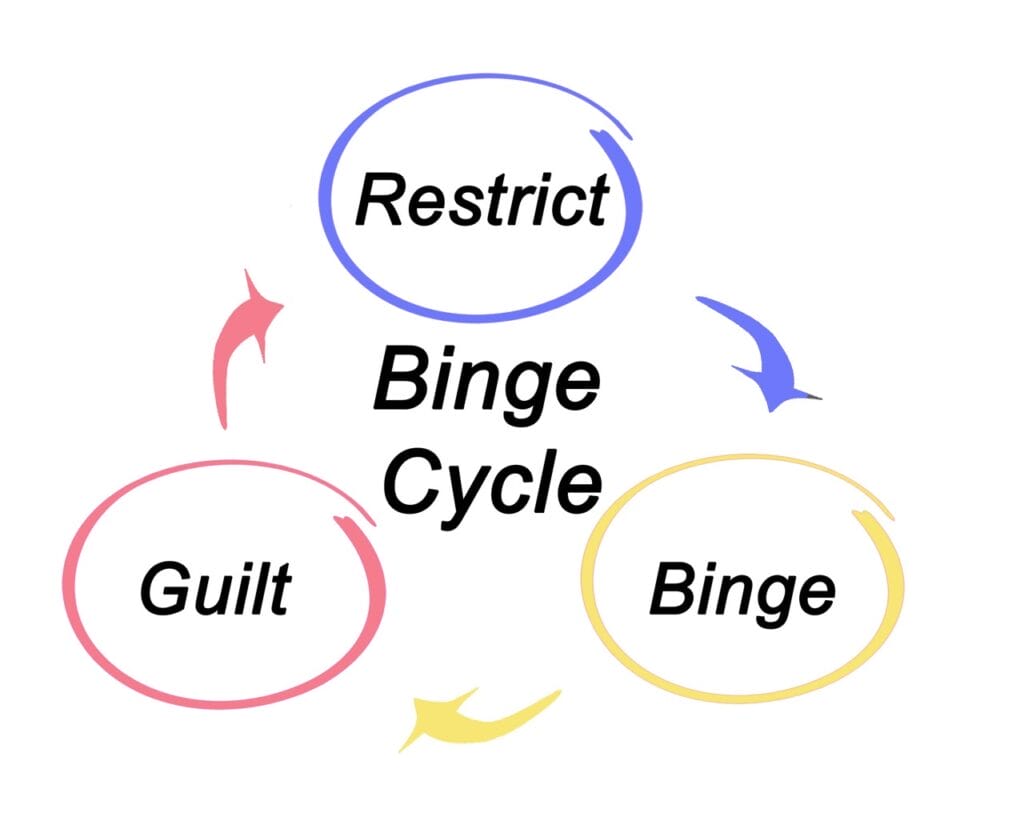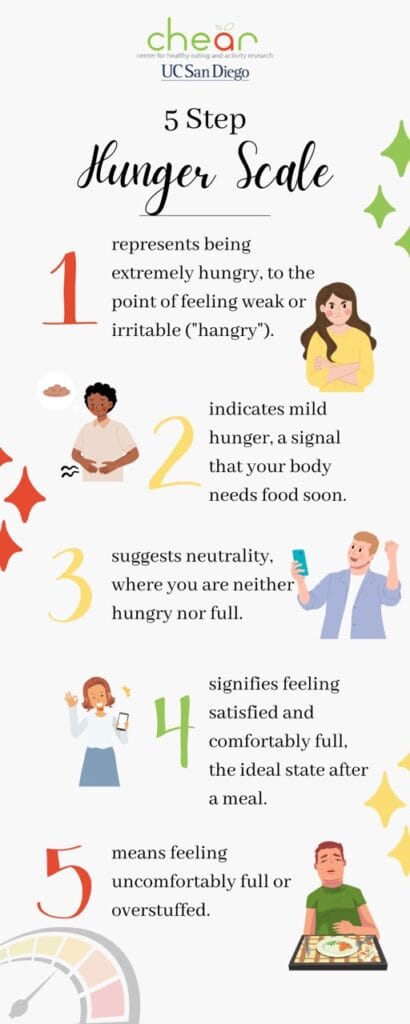In today’s society, dieting is the norm for controlling the weight and shape of our bodies. Yet, dieting can have unintended outcomes that conflict with these goals and create a fractured relationship with food and eating. The diet narrative may lead individuals to engage in periods of restrictive behaviors such as strict dieting, skipping meals, eating very little calories, and avoiding certain foods. Ultimately, leaving individuals hungry and unsatisfied. Our bodies are biologically wired to overcompensate for these periods of restriction. Biological mechanisms kick-in and drive us to experience increased hunger signals and potentially eat more than we intended because our bodies recognize these periods of restriction as “famine” or “starvation”. This is known as the binge-restrict cycle.
Binge-Restrict Cycle
The binge-restrict cycle is a pattern of disordered eating that involves alternating between periods of strict food restriction and episodes of binge eating. This cycle is not only a psychological phenomenon but is also deeply rooted in biological responses to perceived scarcity of food. Understanding the binge-restrict cycle requires exploring its components, triggers, and the underlying psychological and biological mechanisms.
The binge-restrict cycle explains how this biological and survival mechanism comes into play. After a period of restriction our bodies feel deprived, which can prompt an overwhelming urge to eat. When we do eat after restricting, we can eat past fullness or overeat to compensate for restriction. A sense of loss of control could be present because our survival mechanism to eat and conserve as much food as possible takes over so that we can outlast the next “famine”.
Some individuals experience feelings of guilt and shame following a binge episode, especially if they were “trying to be good” or follow a diet. It can feel like a failure. This can lead to restriction of diet again to regain control and “make-up” for a binge. However, the restriction after a binge maintains this cycle.
Regular Patterns of Eating
One of the most helpful tools for interrupting the restrict-binge cycle is following regular patterns of eating. This is characterized by making a conscious effort to eat every 3-4 hours; including 3 meals and 2 snacks. Snacks and meals should be balanced and include things that will be nutritious, satisfy you, and keep you full; including fruits, vegetables, proteins, carbs, and fats. It’s also important to add food you enjoy, not just what you think you “should” have. This means planning your meals to include foods like chips and cookies or other previously avoided food. Cutting these foods completely could increase the chance of reengaging in the binge-restrict cycle.
A helpful guiding phrase for food choices is “Eat what you want, add what you need!” For example, if you want chips – have some chips! And add what you need, such as protein or fruit.
At first, it might be challenging to decide how much to eat for each meal and snack. Taking your hunger rating before, during, and after a meal can be a helpful tool here. Check in with yourself on a scale of 1-5 (1 – extremely hungry, 2 – mildly hungry, 3 – not hungry or full, 4 – full and satisfied, 5 – too full and uncomfortable). The goal is to reach a 4 after every meal and snack and not drop below a 2 between periods of eating.
As you begin to eat regularly and take your hunger ratings, it will be easier to identify how much food is enough for you. This is highly individualized and takes mindful practice. So, be patient with yourself and be willing to modify your plan as you go!
Let’s look further into this topic for a better understanding.
The Paradox of Dieting
The widespread acceptance of dieting as a method for managing body weight and shape is deeply ingrained in modern culture. This societal norm, driven by aesthetic ideals and health concerns, encourages individuals to adopt various forms of dietary restrictions. Yet, the initial intentions behind dieting often clash with the reality of its effects, leading to outcomes that contradict the pursuit of health and well-being.

Dieting, particularly when it involves severe calorie restriction, skipping meals, or eliminating specific food groups, sets the stage for a disrupted relationship with food. Instead of promoting health, these restrictive practices often foster a cycle of deprivation and excess. The body, in response to what it perceives as a state of famine, initiates biological mechanisms designed to protect against starvation. This includes ramping up hunger signals and enhancing the desire to eat, particularly high-energy foods, to replenish the energy reserves depleted during periods of restriction.
Biological and Psychological Repercussions
The body’s natural reaction to restriction is not merely a physiological response but also triggers psychological effects. After a period of denying oneself food, the eventual consumption often leads to overeating, surpassing fullness and leading to physical discomfort and emotional distress. This overconsumption, especially following a period of strict dieting, is frequently accompanied by intense feelings of guilt and shame, stemming from the perceived failure to adhere to self-imposed dietary rules.
The binge-restrict cycle is thus both a biological and psychological phenomenon. Biologically, it is a survival strategy, an innate response to energy scarcity. Psychologically, it reflects the internal conflict and emotional turmoil associated with failing to meet personal or societal dietary expectations. This cycle can become a self-perpetuating loop, where each phase reinforces the next, making it increasingly difficult to break free.
The Binge-Restrict Cycle Explained
Biological Response to Restriction: The body is biologically programmed to respond to periods of food restriction as if they were times of famine. This triggers mechanisms that increase hunger signals, pushing individuals to consume more than intended once they start eating again.
Cycle Dynamics: The binge-restrict cycle begins with deprivation, leading to an overwhelming urge to eat, often resulting in consuming past fullness to compensate for earlier restriction. This phase can be accompanied by a sense of loss of control, followed by feelings of guilt and shame, especially if the individual was attempting to adhere to dietary rules. In response, one might restrict food intake again in an effort to regain control and counteract the binge, perpetuating the cycle.

Breaking the Cycle
Understanding the dynamics of the binge-restrict cycle is crucial for those trapped within it. Recognizing that this cycle is a natural response to unnatural eating patterns can be liberating. It shifts the blame from personal failure to a broader understanding of how human biology and psychology interact with diet culture. The first step toward breaking this cycle involves acknowledging the detrimental impact of restrictive diets on both body and mind. From there, individuals can begin to explore more sustainable approaches to eating, focusing on nourishment, balance, and satisfaction rather than restriction and control.
The journey away from the binge-restrict cycle and towards a healthier relationship with food is complex and deeply personal. It requires patience, self-compassion, and often, the guidance of professionals who understand the intricacies of eating behaviors. By moving towards eating patterns that honor the body’s needs and respecting its signals of hunger and fullness, individuals can start to heal the rift between their bodies, their minds, and their meals.
Transitioning from this foundational knowledge, we find that one of the most effective strategies to combat the binge-restrict cycle lies in adopting regular patterns of eating. This approach emphasizes the importance of consistent, balanced meals and snacks that not only nourish the body but also satisfy the palate. By ensuring that our eating habits include a variety of nutritious and enjoyable foods, and by listening to our body’s hunger and fullness cues, we can begin to mend our relationship with food. The principle of “Eat what you want, add what you need” serves as a guiding light in this journey, advocating for a more balanced diet and inclusive approach to eating that steers clear of the all-or-nothing mentality often associated with dieting.
Adopting Regular Eating Patterns
Breaking the Cycle: One effective method to interrupt the binge-restrict cycle is to adopt regular eating patterns. This involves eating every 3-4 hours, including three meals and two snacks, to prevent extreme hunger and reduce the urge to binge.
Balanced and Enjoyable Eating: Meals and snacks should be balanced, incorporating a variety of nutritious foods from all food groups—fruits, vegetables, proteins, carbohydrates, and fats. It’s also crucial to include foods that you enjoy, to prevent feelings of deprivation that can trigger bingeing.

Guiding Principle for Food Choices: The mantra “Eat what you want, add what you need” encourages a balanced approach to eating. It supports including desired foods, like chips or cookies, in moderation, alongside necessary nutrients like protein or fruit.
As we explore the principles of regular eating patterns and mindful eating practices further, it’s crucial to recognize the individualized nature of this process. Learning to understand and respect our body’s unique hunger signals requires patience, practice, and a willingness to adapt. This path towards a healthier relationship with food not only challenges the dieting narrative but also opens the door to a more fulfilling and balanced approach to eating and well-being.
Mindful Eating and Hunger Ratings
Mindful eating and the use of hunger ratings are key components in developing a healthier and more intuitive relationship with food. These practices encourage individuals to tune into their body’s cues, helping them to eat in response to physical hunger rather than emotional triggers or external cues, such as time of day or food availability. Here’s a closer look at these concepts:
Assessing Hunger and Fullness
The process of assessing hunger and fullness involves consciously checking in with yourself to gauge your level of hunger or satisfaction. This can be done using a simple scale from 1 to 5, where:
1 represents being extremely hungry, to the point of feeling weak or irritable (“hangry”).
2 indicates mild hunger, a signal that your body needs food soon.
3 suggests neutrality, where you are neither hungry nor full.
4 signifies feeling satisfied and comfortably full, the ideal state after a meal.
5 means feeling uncomfortably full or overstuffed.
By regularly assessing these levels before, during, and after meals, you can start to identify the amount of food your body actually needs to feel satisfied. This practice helps prevent overeating by stopping at a ‘4’, and encourages eating when hunger first begins to signal, aiming not to drop below a ‘2’.
Personalized Eating Plans
Mindful eating emphasizes that there is no one-size-fits-all approach to nutrition and that eating plans should be personalized. This personalization is crucial because everyone’s body, lifestyle, and nutritional needs are unique. It involves:
Listening to Your Body: Paying attention to your body’s signals rather than adhering strictly to prescribed meal times or portion sizes.
Patience: Recognizing that learning to interpret your body’s signals accurately is a process that takes time and practice.
Flexibility: Being willing to adjust what, when, and how much you eat based on your ongoing experiences with hunger and fullness.
Implementing mindful eating and hunger ratings into your life is more than just a method for managing food intake; it’s about fostering a deeper connection with your body. It encourages eating with intention and attention, where the focus is on the experience of eating, the quality of the food, and its impact on the body.
This mindful approach to eating can transform your relationship with food. It moves you away from restrictive dieting patterns and towards a more balanced and healthful way of eating that aligns with your body’s natural needs. Through mindful eating, you learn to trust your body’s wisdom in guiding your food choices, leading to improved well-being and satisfaction.
Conclusion
In conclusion, navigating the complexities of diet culture, the binge-restrict cycle, and the journey towards establishing regular, mindful eating patterns illuminates the intricate relationship between our bodies, our minds, and the food we consume. Understanding the counterproductive nature of restrictive dieting and embracing the principles of mindful eating and hunger awareness are pivotal steps towards fostering a healthier, more harmonious relationship with food.
By listening to our bodies’ natural cues for hunger and fullness, and allowing ourselves the flexibility to enjoy a wide variety of foods, we empower ourselves to break free from the cycles of restriction and overeating. This journey is deeply personal and requires patience, self-compassion, and a willingness to learn and adapt.
Remember, the goal is not perfection but progress towards eating in a way that nourishes both the body and the soul.
As we move forward, let us embrace the practice of eating mindfully, honoring our individual needs, and celebrating the joy that food can bring into our lives.





